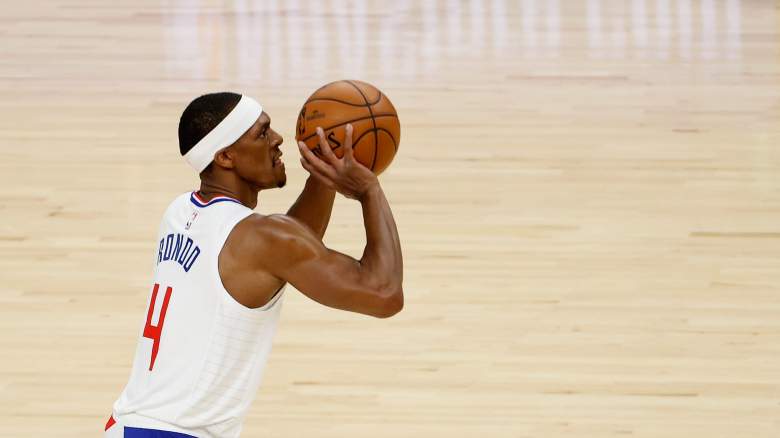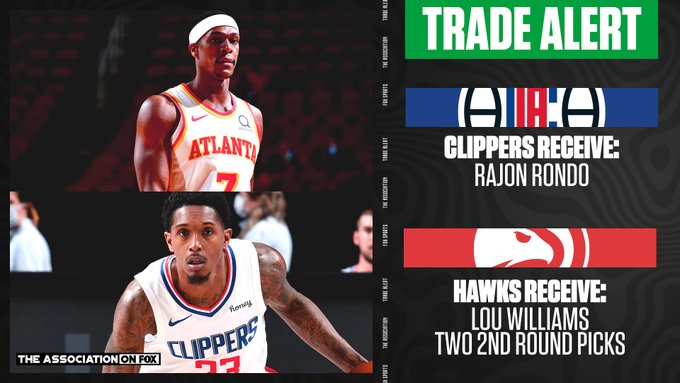
Getty Rajon Rondo gets ready to release
When, back in March at the trade deadline, the Clippers traded Lou Williams to the Hawks in exchange for Rajon Rondo, the move was considered bittersweet for many around Clipper Nation.
Williams was, after all, a fan favorite for his cool demeanor and for being one of the team’s most consistent offensive threats. In three-plus seasons with the Clippers, Williams averaged 19.1 points and 5.1 assists and was twice awarded NBA Sixth Man of the Year, in 2017-18 and 2018-19. (Williams also won the award in 2014-15 as a member of the Toronto Raptors.)
But the thin, 6-foot-1 Williams was a liability on defense, regularly targeted by opponents for mismatches. And, as primarily a scorer, he was less-equipped to run the offense and get consistent good looks for the team’s two main attractions, Kawhi Leonard and Paul George — a necessity, the Clippers believed, for a long postseason journey. The Clippers also had Patrick Beverley, who was injured at the time, but even when healthy has never been a traditional point guard offensively.
Rondo, on the other hand, though playing poorly for Atlanta (3.6 points, 3.5 assists and 1.4 turnovers in 27 games) was a four-time All-Defensive selection over 15 seasons and was considered a premier floor leader, someone who could push the ball up the court and facilitate. Additionally, and perhaps most crucially, Rondo had helped two teams win NBA rings, including the Lakers one year earlier.
“Know that Playoff Rondo is a real thing,” said Clippers president of basketball operations Lawrence Frank at the time. “It’s because he dials it up and he becomes even more locked in and it has a very contagious effect.”
But now, according to The Athletic’s Law Murray, in the wake of another failed title run — albeit the longest run in franchise history — the Williams-Rondo trade doesn’t seem as wise as it once did.
The Rise and Fall of Rondo
On Wednesday, in a comprehensive look at the Clippers’ player transactions this season, Murray gave a final grade to the Rondo trade: C-.
On the bright side of things, Murray points to the Clippers’ success in the regular season immediately following Rondo’s arrival, noting that “Rondo had only one game in April where the Clippers were outscored during his minutes (a loss at New Orleans).”
Indeed, the Clippers went 9-1 in Rondo’s first 10 games, and teammates and coaches were effusive about what he brought to the table.
“He was great,” head coach Ty Lue said following an April 8 win over Phoenix in which Rondo had 15 points and nine assists in just under 20 minutes. “Doing everything we thought he was going to do when he came out here. Just controlled the game, controlled the tempo, making some great passes for guys to have open shots and layups. And defensively, he was great as well. He was talking and communicating.”
Murray also notes the positive effect Williams leaving had on Reggie Jackson’s season, allowing the once forsaken guard to “flourish” as his minutes rose. In the Clippers’ first 45 games, with Williams on the squad, Jackson averaged 20.8 minutes a game and just 8.7 points. But in the final 27 games, Jackson’s minutes rose to 27.4 and his points nearly doubled to 14.0.
The confidence those numbers engendered surely made a difference in the playoffs when Jackson became one of the team’s most reliable scorers, averaging 17.8 and playing himself into what is expected to be a big payday this offseason for the unrestricted free agent.
But what ultimately made the Rondo trade a net-sum loss to Murray was, ironically, Rondo’s playoff performance.
While Murray asserts that Rondo was “definitely a positive factor” in the Clippers’ first-round series win over the Mavericks, particularly in Games 3 and 4 when the team was a plus-36 when Rondo was on the floor, he highlights Rondo’s ineffectiveness in the two subsequent rounds.
Murray writes:
It did seem like Rondo’s usefulness evaporated as soon as the calendar hit June. The Clippers were outscored by 19 points in the Game 5 home loss to the Mavericks that saw Rondo miss all six of his shots and stare a hole through Kawhi Leonard after the latter missed everything on a late 3. Rondo didn’t play in Games 2-4 against the Jazz, only re-emerging in the rotation when Leonard was injured. After a three-turnover performance in Game 3 against the Suns, Rondo never played again, despite Lue’s need for another ballhandler when George rested. Rondo missed 11-of-13 2-point shots in June, and made a postseason career-low 34 percent of his field goals overall.
Of course, a C- grade is not a failing grade, but it is clearly not what the Clippers had in mind when they gave up a “franchise icon,” as Murray describes Williams, and two-second round picks to get Rondo.
Clippers Have Headaches at Point Guard
Another consequence of the Williams-Rondo trade is that, short of another trade or the team waiving him, Rondo will be a Clipper for another year. Williams was on an expiring contract but Rondo was in the first year of a two-year deal he signed with Atlanta, and is owed $7.5 million for next season.
$7.5 million is not an exorbitant amount, to be sure, but if Rondo is no longer even a serviceable backup point guard, then the Clippers will have to do even more work this offseason on upgrading that position — something they already needed to do given Jackson’s expected departure and the increasingly common injury woes of Patrick Beverley.
Well over the salary cap for next season and without a moveable first-round pick until 2027, L.A. doesn’t have a lot of wiggle room. They either need to use their $6 million taxpaying mid-level exception on a veteran point guard — someone like TJ McConnell, Patty Mills, Devonte’ Graham or Ish Smith — or hope that another team is willing to part with a point guard in a straight-up trade or a sign-and-trade.
The team does have some enticing tradable assets — notably, center Ivica Zubac and guard Terance Mann — but moving one or both of those guys, as part of a larger deal for someone like Brooklyn’s Spencer Dinwiddie or Toronto’s Kyle Lowery, would leave significant gaps in other areas.
With Serge Ibaka’s future as uncertain as ever following back surgery, Zubac is essentially the last man standing down low for the Clippers. And besides, L.A. likes the progress Zubac has made the last two seasons and would prefer to keep the durable 24-year-old.
The same goes for Mann, who was one of the league’s breakout stars this season, and whose versatility on both ends of the floor would not be easily replaceable (especially if and when he develops a consistent jump shot). Incidentally, growing up Mann was a huge fan of Rondo.
And while George, who signed a big extension in December, would obviously reap much in the trade market, any deal that involved him would almost certainly need the blessing of Leonard, who was the impetus behind George joining the Clippers in the first place and is currently deciding what to do with his player option in this the final year of his contract. Even entertaining a George trade, therefore, is almost futile until Leonard makes a decision.


